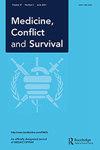巴基斯坦的洪水危机:对经济和脆弱的卫生保健系统的大规模破坏。
Q3 Medicine
引用次数: 3
摘要
本文章由计算机程序翻译,如有差异,请以英文原文为准。
Flood Crisis in Pakistan: a mass destruction to economy and fragile health care systems.
Flooding has occurred in Pakistan as a result of unprecedented rainfall, particularly in the provinces of Baluchistan and Sindh. Torrential monsoon rains caused the worst floods in Pakistan’s history, destroying communities and leaving over 3.4 million children in need of aid and at heightened risk of waterborne infections, drowning, and starvation. The extent of the destruction is becoming clear as the floodwaters recede. There is a need for government and international organizations to intervene now to implement public health initiatives and multi-sectoral strategies. In Pakistan, the monsoon season is still having an impact on several provinces, bringing with it floods, flash floods, and other severe weatherrelated occurrences, as well as a greater socioeconomic burden. This flooding is attributed to record-breaking rainfall, especially in the provinces of Baluchistan and Sindh (CDC n.d.). As of September 8th, the National Disaster Management Authority (NDMA) estimates around 1,400 fatalities and over 12,700 injured (ReliefWeb 2022). Floods have a variety of effects on human health which may be affected directly by coming into contact with floodwaters or indirectly by damage to infrastructure, ecology, food security, and water supply. The effects of floods might show up immediately or within days, weeks, or even months after the floods have subsided.
求助全文
通过发布文献求助,成功后即可免费获取论文全文。
去求助
来源期刊

Medicine, Conflict and Survival
Medicine-Pathology and Forensic Medicine
CiteScore
1.80
自引率
0.00%
发文量
46
期刊介绍:
Medicine, Conflict and Survival is an international journal for all those interested in health aspects of violence and human rights. It covers: •The causes and consequences of war and group violence. •The health and environmental effects of war and preparations for war, especially from nuclear, radiological, chemical and biological weapons of mass destruction. •The influence of war and preparations for war on health and welfare services and the distribution of global resources . •The abuse of human rights, its occurrence, causes and consequences. •The ethical responsibility of health professionals in relation to war, social violence and human rights abuses. •Non-violent methods of conflict resolution.
 求助内容:
求助内容: 应助结果提醒方式:
应助结果提醒方式:


